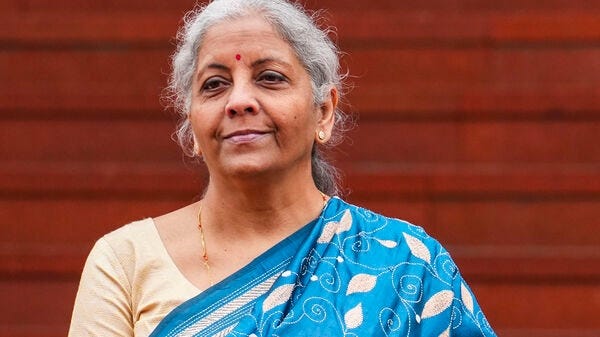Interim Budget 2024-25: Contours of the Shape of Things to Come in the Next 5 Years
The Finance Minister's gorgeous sari, a deep shade of blue, beautifully contrasted with her portrayal of the economy, which she described as being in the pink of health during her speech.
Interim Budget 2024-25
The Interim Budget 2024-25, presented by Finance and Corporate Affairs Minister Smt Nirmala Sitharaman, serves as a prelude to the comprehensive financial blueprint set to be unveiled later in the year. This “vote-on-account” is a precursor to the Finance Bill and the Appropriation Act, essentially a temporary arrangement for fund withdrawals from the Consolidated Fund of India until the end of July 2024.
Despite not generating the usual hype of a regular Budget, this interim statement was keenly anticipated by markets, economists, academicians, and statisticians. It is not just an “Annual Financial Statement” as referred to in Article 112 of the Constitution but a reflection of the socio-economic and political priorities of the Government, especially significant as the last budget before the 2024 Lok Sabha elections.
Stay tuned for out 5 Unique Insights
As we work on our in-depth analysis on the five key proposals or highlights from the Interim Budget 2024-25, focusing on areas that spark optimism, warrant caution, or require further elaboration, let's first succinctly summarize the salient features already available in the public domain. This concise write-up is aimed at setting the stage for our comprehensive and unique insights to be published by 4:00 AM tomorrow (2nd February), ahead of widespread media coverage (now online):
Salient Features from Part “A” of the Speech
Part A: Economic Growth and Developmental Projections
Capital Expenditure Increase: The capital expenditure for the next year is set to increase by 11.1% to ₹11,11,111 crore, accounting for 3.4% of the GDP. This follows a significant tripling in the capital expenditure outlay over the past four years, contributing to economic growth and employment.
GDP Growth Projections: India's Real GDP is projected to grow at 7.3%, in line with the RBI's revised projections. The IMF's upward revision of India's growth projection to 6.3% for FY2023-24 underscores global confidence in the Indian economy.
The Fiscal Deficit as a percentage of GDP for the current financial year (2023-24) is estimated at 5.8%, slightly lower than the initially budgeted 5.9%. This marks a reduction from the previous year's (2022-23) figure of 6.4%. Looking ahead, it is projected to be further reduced to 5.1% in 2024-25. This trajectory aligns with the government's long-term fiscal consolidation plan, aiming to bring the deficit below 4.5% by the fiscal year 2025-26.
International Outlook: India is poised to become the third-largest economy by 2027, with a significant increase in its contribution to global growth. Growth projections by various international agencies for 2024-25 range between 6.1% and 6.7%.
Revenue Collections: The budget highlights robust revenue collections, with GST collection reaching ₹1.65 lakh crore in December 2023. Direct tax collection tripled, return filers increased to 2.4 times, in the last 10 years.
Salient Features from Part “B” of the Speech
Part B: Taxation and Fiscal Policies
Taxation Stability: No changes in taxation rates were proposed. The current rates for direct and indirect taxes, including import duties, remain unchanged. However, tax benefits for Start-Ups and certain investments have been extended.
Direct Tax Demands: The budget proposes to withdraw outstanding direct tax demands, dating as far back as 1962, to alleviate taxpayer concerns and streamline the system.
Tax Collections and Compliance: Direct tax collections have more than tripled over the last decade. The GST regime has reduced compliance burdens, doubling the tax base and increasing average monthly gross GST collections.
Customs and Trade: Steps taken in customs have facilitated international trade, significantly reducing import release times.
Future Outlook
The Interim Budget lays the groundwork for "Viksit Bharat" (Developed India) by 2047, with a focus on inclusive and comprehensive development covering all sectors and demographics. The commitment to social justice, improved governance, and sustainable economic growth is evident. A White Paper detailing the economic progress since 2014 is anticipated, aimed at drawing lessons from past economic management and setting the stage for future developmental trajectories.
This Budget is a key indicator of the Government's priorities and strategic direction as India gears up for the 2024 Lok Sabha elections and beyond, charting a path towards holistic development and economic prosperity.
But do stay tuned for our in-depth analysis on five of the highlights of this voluminous Budget that require further elucidation. Online at 4:00AM IST tomorrow, Friday (read here).







